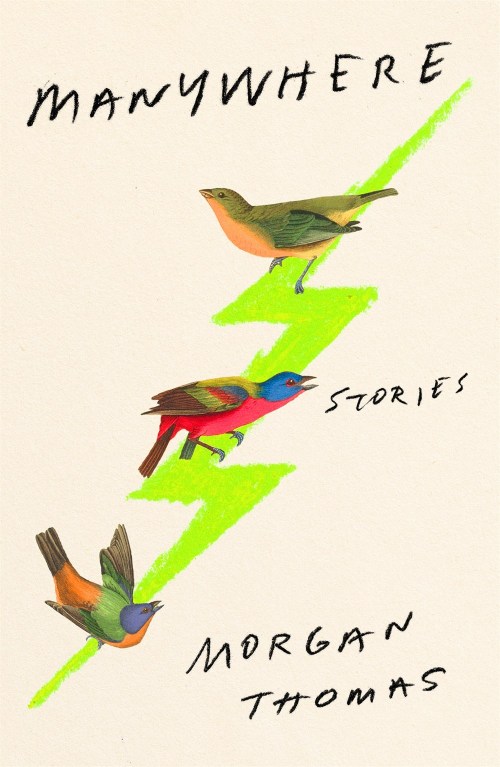[ad_1]
For me, as a musician, one mark of a great short story collection is when it operates somewhat like a great symphony: cast in distinct movements, moving through different moods, tonalities and orchestrations, but at some base level—whether heard or simply felt—motivically and thematically cohesive. Manywhere, Morgan Thomas’ expansive and expressive debut collection, is this kind of book. Though the nine stories within it are not linked in character or plot, they are woven from the same cloth. Combining astute research, invention, and an endlessly imaginative inquisitiveness, taken together they create a rich tapestry of stories, each with its own vivid threadwork.
These stories are often populated with characters who are in transit, fleeing, searching—but Manywhere is filled with exits that are not as much about leaving things behind as about the process of carving spaces for new, sometimes unexpected discoveries of histories, lineages, and selves. The collection is dedicated to “anyone who’s gone looking for themself in the archives,” and Thomas’ characters often find themselves combing through these archives—social and family histories, quasi-mythic tales of ancestors and foreparents—to claim (or renounce) what the lives of those who came before them might suggest about their own.
They dig for something beyond themselves, or something already a part of them but buried; what they pursue may not exist, may not be real, but more often than not they nonetheless see the value in the pursuit itself. In “Bump,” a trans woman begins wearing a strap-on pregnancy bump as “the enactment of a ritual” without the purpose of a usual pregnancy: “The bump moved with me, part of me. Not a false thing. A thing that served its own purpose, parallel to pregnancy, not a ghost of it, a different thing altogether.” Likewise, in “Surrogate,” a character named Brighten finds through the act of surrogacy a “reason to be gentle” with herself.
Then, too, there are characters who are literally departing. They are messy, complicated, gritty, at their rope’s end; they leave relationships, escape natural disasters, flee persecution. In “The Daring Life of Philippa Cook the Rogue,” the story of a young Virginian’s interest in Cook, an intersex person from Colonial-era Jamestown, unfolds through letters, emails, diaries, and court depositions that span centuries and continents—this technique of assemblage is used in other stories to equally strong effect. As we learn of Cook’s escape from persecution via the letters written by and about them in 17th-century Virginia and the Netherlands, the present-day story of Shoo and Reed’s breakup unfolds as Shoo becomes obsessed with tracking down Cook’s letters.
Place and identity are inextricably linked in these stories. Thomas captures the visual, atmospheric, and emotional textures of life in the American South so vividly that you can’t imagine these characters existing anywhere else: “In those trucks, above the beat of air through the windows and the drawl of the radio, they talked about the land awaiting them.”
Two of the stories, in fact, have “place” in their title. (Another is titled “Transit.”) In the mesmerizing, lyrical story “Alta’s Place,” the narrator, Cory, befriends Alta, a Mongolian woman seeking asylum in the United States, and begins making weekly visits to her home to pick up and drop off dry cleaning. As Cory searches for meaning in the stories Alta tells of her past, including accounts of her life as a lesbian woman in Mongolia, a closeness develops between them, though it is Cory who feels this most strongly. Alta’s home, as the story’s title suggests, itself takes on a significance for her: “It matched my vision of intimacy, to sit silently in the corner of someone else’s life until she stopped noticing.” But Cory ultimately becomes conscious of being an outsider looking in at another’s life—at all the unknowable parts of that person.
Thomas, in their own way, seems to take influence from Southern literature’s tendency to use mythic histories to provide models for how (or how not) to live. Here, there is queer mythmaking, but there is also historicization. Some, though not all, of the historical characters populating these stories are actual historical figures, while others are based loosely on historical circumstances. (Endnotes explain Thomas’ references in detail.)
Throughout the collection, Thomas asserts themself as a writer of thematic breadth and imaginative depth. The writing, too, is consistently impressive: acerbic dialogue sits side by side with lyrical passages that almost read as prose poems. Metaphor and image—in “Surrogate,” the intoxicating image of flame—are so cohesive within each story that each feels at once airtight and effortless. But it is as a storyteller, in the most literal sense, that Thomas finally triumphs. Their ear for vernacular, capability for invention, and sense of the nuances of human intimacy—particularly that more elusive intimacy with the contours of one’s own experience—make it no wonder that their characters are themselves such vivid storytellers.
In this sense, Manywhere is also a love letter to storytelling, to its capacity to challenge binaries and expectations and its capacity for malleability. In “Transit,” the narrator says, “They couldn’t stand it, staying in this place meant for passing through […] I was comfortable here, comfortable in the moment before a ticket was bought, when you could decide to travel either way.” Transitory spaces can be appealing in their open-endedness; the die may be recast, the narrative might swerve. So too in stories—those we tell others and those we tell ourselves: details can be revised, histories can be reclaimed. “This is […] the moment I’d change,” the narrator writes in “Bump.” “Writing it down like this, I am changing it.”

FICTION
Manywhere
by Morgan Thomas
MCD
Published January 25th, 2022
[ad_2]
Source link

